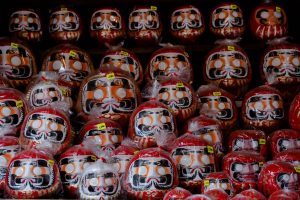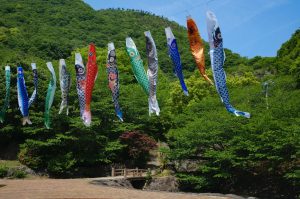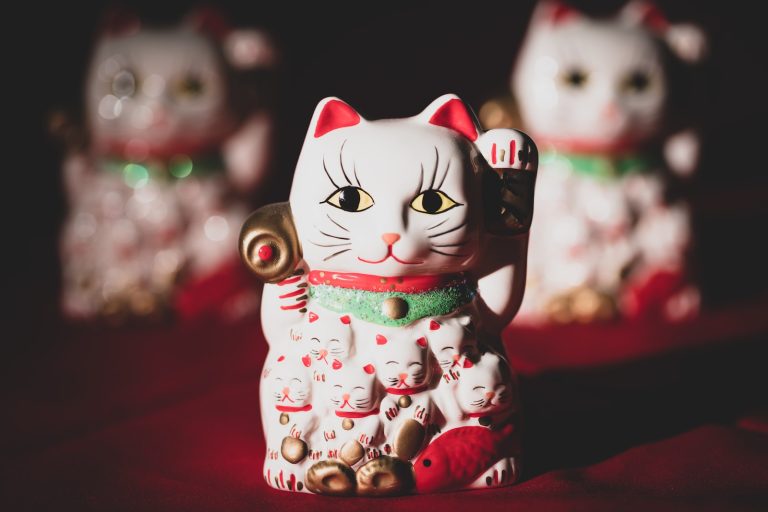Japanese culture is rich with symbolism, and one of the most fascinating aspects is the use of good luck symbols. These symbols are believed to bring fortune, success, and happiness to those who possess or display them. From the well-known Maneki-Neko or Beckoning Cat to the less common Japanese kanji symbols, there are many ways to incorporate good luck symbols into your life. In this post, we’ll explore some of the most popular Japanese good luck symbols, their meanings, and how they can bring hope and happiness to your life.
Japanese Good Luck Symbols
Japanese culture has long been associated with good luck symbols and objects that are believed to bring fortune, success, and happiness. Here are some of the most popular Japanese good luck symbols:
Maneki-Neko (Lucky Cat)
One of the most popular Japanese good luck symbols is the Maneki-Neko or Lucky Cat. This charming figurine is often seen in Japanese businesses and homes, welcoming good fortune and beckoning customers. The Maneki-Neko is a cat figure with one or both paws raised, as if waving. The figurine is believed to bring good luck and success in business, making it a popular symbol among business owners and entrepreneurs.
The Lucky Cat is available in many different colors, each with a different meaning. For example, a white Lucky Cat symbolizes happiness, while a black Lucky Cat is believed to ward off evil spirits. The left paw raised is said to attract customers, while the right paw raised brings wealth and good fortune. Some Lucky Cats also hold different items, such as a gold coin or a fish, which represent wealth and prosperity.
In addition to figurines, the Lucky Cat can also be found in other forms, such as fortune symbol stickers or decals. Many people choose to display these decals in their cars or homes to bring good fortune and luck wherever they go.
Daruma Dolls

Daruma Dolls are another popular Japanese good luck symbol. These dolls are usually made of paper mache or ceramic and are shaped like a round, bald-headed human form. The Daruma Doll is an auspicious symbol of good fortune and success, and it is commonly used for goal-setting and achievement.
When a person sets a goal, they color in one eye of the Daruma Doll. Once the goal is achieved, the other eye is colored in. The Daruma Doll is often used during exam time, job interviews, and other important events where success is desired.
Daruma Dolls come in many custom colors, and some even have the kanji for sure win or victory printed on them. They are traditionally sold at Shinto shrines and temples, and many Japanese people keep them in their homes as a good luck charm.
Omamori
Omamori is a small Japanese amulet or talisman that is believed to bring good fortune and protection. These amulets are often sold at Shinto shrines and Buddhist temples throughout the country, and they are popular among visitors who are seeking good luck.
Omamori comes in many different types, each with its own purpose. Some are meant to bring good fortune, while others are meant to bring health or longevity. They are often made of colorful fabric and are decorated with Japanese kanji symbols, which represent the wishes of the person who purchased them.
Many people carry an Omamori with them wherever they go, and some people even attach them to their bags or keychains. They are believed to protect the wearer from harm and bring good luck to their lives.
Ema
Ema are small wooden plaques that are used for making wishes at Shinto shrines. These plaques are often shaped like a postcard and are decorated with colorful images and Japanese kanji symbols. The tradition of writing wishes on Ema dates back to the Heian period in Japan, and it is still practiced today.
When a person visits a shrine, they can purchase an Ema and write their wish on it with a black marker. They then hang the Ema on a designated area on the shrine grounds. The wishes written on Ema can range from personal desires to more general ones such as world peace or good health.
The word Ema is derived from the Japanese words for “horse” and “picture,” as the original Ema plaques were horse-shaped and used to depict horses. This tradition has since evolved, and today Ema can depict a wide range of images, from animals to deities, and even popular culture icons.
Koinobori

Koinobori are carp-shaped streamers that are traditionally flown in Japan on Children’s Day, which is celebrated on May 5th. The carp is a symbol of perseverance and determination because it is believed to swim upstream, overcoming obstacles in its way.
The streamers come in various colors and sizes, and they are often displayed outside homes, businesses, and other public places. Koinobori is a fun and colorful way to celebrate Children’s Day, and it is also believed to bring good fortune and success to children as they grow up.
Kit Kat
The Japanese Kit Kat is a popular snack that has become a symbol of good luck and success. The name Kit Kat is similar to the Japanese phrase “Kitto Katsu,” which means “surely win.” As a result, Kit Kat has become a popular gift during exam time or other important events where success is desired.
In addition to the name, Kit Kat also has a unique flavor for each season and occasion. For example, there is a Sakura-flavored Kit Kat for spring and a Rooster-shaped Kit Kat for the Year of the Rooster. Kit Kat is a unique way to incorporate good luck into your life while enjoying a tasty treat. It is a lucky charm that is sure to bring you good fortune.
Fukusasa
Fukusasa, also known as a lucky broom, is an important symbol of luck and prosperity in Japan. The fuku means “good luck” and the sa means “broom,” which together make a lucky broom. This traditional item can be found in many Shinto shrines as well as in homes, where it is common to hang a fukusasa above the main entrance for protection and good luck.
Fukusasa can come in various designs and colors, from traditional straw brooms to more modern versions made of bamboo or paper. They are believed to bring good fortune to the home and ward off evil spirits. Fukusasa is a great way to add a touch of luck and prosperity to any home.
Other Good Luck Symbols
There are many other good luck symbols in Japanese culture, such as:

- The Beckoning Cat: A cat-shaped figurine that is often found in Japanese businesses and homes, believed to bring good luck and prosperity.
- Dragon: A symbol of power and strength, often used in Japanese art and decoration.
- Spider: In Japanese folklore, spiders are believed to bring good luck and wealth.
- Buddha: The Buddha is often seen in Japanese homes and temples, representing peace and enlightenment.
- Origami: The art of paper folding is believed to bring good luck and fortune, as well as promoting creativity and concentration.
- Rooster: A symbol of good fortune and business success, often found in Japanese businesses.
- Paw: The paw print of a lion or tiger is a popular symbol of strength and power.
Conclusion: Japanese Good Luck Symbols
Japanese good luck symbols are a fascinating and interesting aspect of Japanese culture. From the popular Maneki-Neko and Daruma Dolls to the lesser-known Koinobori and Ema, there are many ways to incorporate good luck symbols into your life. Whether you are looking for success in business, health, or personal relationships, there is a Japanese good luck symbol that can help bring you good fortune and happiness.
If you are planning to visit Japanese cities like Tokyo, Osaka, or any other city in Japan, be sure to explore the different good luck symbols and traditions that are unique to each region. And who knows, you may just discover a new good luck charm that will bring happiness and success to your life.
Other suggested articles:

